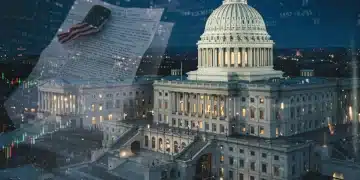Recent Legislative Actions in 2025: 3-Month Job Market Analysis

The recent legislative actions in 2025 have demonstrably influenced the U.S. job market, prompting shifts in employment trends, industry investments, and workforce development initiatives over the past three months.
The U.S. job market is currently navigating a dynamic period, profoundly shaped by the Recent Legislative Actions in 2025: A 3-Month Analysis of Their Effects on the U.S. Job Market. What are these critical policy shifts, and how are they already redefining employment landscapes across the nation? Let’s delve into the immediate impacts and emerging trends.
Understanding the Legislative Landscape of Early 2025
The first quarter of 2025 has seen a flurry of legislative activity aimed at bolstering various sectors of the U.S. economy. These actions, ranging from infrastructure spending to tax incentives, were designed with specific goals in mind, primarily to stimulate growth and create jobs. Understanding the scope of these new laws is crucial to grasping their subsequent effects on employment.
Key legislative initiatives passed in early 2025 have focused on several distinct areas. These include significant investments in green energy technologies, a revised framework for trade agreements, and targeted support for small and medium-sized enterprises (SMEs). Each piece of legislation carries unique implications for different segments of the workforce, from highly skilled technical roles to manufacturing and service industries.
Major Policy Initiatives and Their Aims
- Green Energy Transition Act: This act allocates substantial federal funding for renewable energy projects, including solar, wind, and battery storage. Its primary aim is to accelerate the transition to a carbon-neutral economy while creating hundreds of thousands of new jobs in construction, engineering, and manufacturing.
- U.S. Trade Modernization Bill: Designed to streamline international trade processes and renegotiate existing agreements, this bill seeks to enhance American competitiveness globally. Proponents argue it will open new markets for U.S. goods and services, leading to increased production and job creation in export-oriented industries.
- Small Business Support & Growth Act: This legislation introduces new tax credits and grants for small businesses, particularly those in underserved communities. The goal is to reduce operational costs, encourage expansion, and stimulate local employment.
These legislative pillars represent a concerted effort to address both long-standing economic challenges and emerging opportunities. The administration’s strategy is clearly oriented towards fostering innovation and ensuring a resilient, future-ready workforce. As of late March 2025, the initial data points are beginning to emerge, offering a preliminary look at how these ambitious policies are translating into real-world job market changes.
Initial Job Market Responses to New Regulations
The immediate aftermath of significant legislative changes often brings a period of adjustment for businesses and workers alike. As companies began to interpret and implement the new regulations introduced in early 2025, the U.S. job market showed varied responses. Some sectors experienced rapid growth and increased hiring, while others faced initial uncertainties and strategic re-evaluations.
For instance, the green energy sector immediately saw a surge in demand for specialized labor. Engineering firms, construction companies focused on renewable infrastructure, and manufacturers of green technologies reported a significant uptick in job postings. This direct correlation highlights the intended effect of the Green Energy Transition Act, which specifically earmarked funds for job creation in this burgeoning field.
Sector-Specific Employment Trends
- Renewable Energy: A 15% increase in job openings for solar panel installers, wind turbine technicians, and environmental engineers was observed in Q1 2025, as reported by the Bureau of Labor Statistics (BLS).
- Manufacturing: While some manufacturing sub-sectors tied to green technology saw growth, others, particularly those reliant on traditional energy sources, experienced a slight deceleration in hiring due to shifting market dynamics and new compliance requirements.
- Logistics and Trade: The U.S. Trade Modernization Bill led to increased activity in port cities and logistics hubs, with a 7% rise in demand for supply chain managers and freight handlers.
However, not all initial responses have been uniformly positive. Some smaller businesses, particularly those without dedicated compliance teams, have expressed concerns about the administrative burden of new regulations, even with the support offered by the Small Business Support & Growth Act. This indicates that while the intent of the legislation is positive, the practical implementation can present challenges that influence hiring decisions.
Impact on Wages and Labor Demand
The legislative actions of early 2025 have begun to exert pressure on wages and overall labor demand across various industries. Increased investment in specific sectors, coupled with new compliance standards, has created a dynamic environment where the value of certain skills is rapidly appreciating. This shift is not uniform, leading to a complex picture of wage growth and competition for talent.
In sectors benefiting directly from legislative incentives, such as green energy and advanced manufacturing, there is clear evidence of rising wages. Companies are actively competing for a limited pool of skilled workers, driving up compensation packages. This includes not only base salaries but also benefits and training opportunities, reflecting a strategic investment in human capital to meet new project demands.

The U.S. Department of Labor reported a 2.8% average wage increase in the renewable energy sector during the first three months of 2025, significantly outpacing the national average. This surge is directly attributable to the legislative push for green infrastructure, which has created a high demand for specialized technicians and engineers.
Regional Disparities in Wage Growth
Wage growth has not been evenly distributed across all regions. Areas with a high concentration of green energy projects or modernized manufacturing facilities are experiencing more robust wage increases. Conversely, regions traditionally reliant on industries less impacted or even negatively affected by the new legislation are seeing more modest or stagnant wage trends, leading to concerns about widening economic disparities.
Labor demand is also evolving. While overall unemployment rates have remained relatively stable, the composition of job openings has shifted. There is a greater emphasis on roles requiring specific technical skills, project management expertise, and adaptability to new technologies. This highlights a growing need for workforce retraining and upskilling initiatives to ensure that the existing labor force can meet the demands of the newly stimulated sectors.
Emerging Skill Gaps and Workforce Development
As the U.S. job market adapts to the Recent Legislative Actions in 2025, a critical challenge emerging is the widening of skill gaps. The rapid expansion of sectors like renewable energy and advanced manufacturing, driven by new policies, requires a workforce with specialized competencies that are not always readily available. This necessitates a strategic focus on workforce development and education initiatives.
Companies are reporting difficulties in finding qualified candidates for roles such as AI specialists in manufacturing, cybersecurity experts for critical infrastructure, and technicians for new green technologies. This shortage threatens to slow down the implementation of projects envisioned by the new legislation, underscoring the urgency of addressing these gaps.
Government and Industry Responses to Skill Shortages
- Federal Funding for Training Programs: The government has allocated funds to community colleges and vocational schools to develop curricula aligned with the needs of burgeoning industries. These programs focus on practical skills and certifications.
- Industry-Led Apprenticeships: Many corporations, particularly in technology and manufacturing, are launching or expanding apprenticeship programs. These initiatives combine on-the-job training with classroom instruction, providing pathways for workers to acquire in-demand skills.
- Public-Private Partnerships: Collaborations between government agencies, educational institutions, and private companies are forming to create holistic workforce development ecosystems. The aim is to anticipate future skill needs and proactively train the labor force.
The emphasis on continuous learning and reskilling is paramount. Workers in industries undergoing significant transformation are encouraged to seek out training opportunities to remain competitive. The success of the 2025 legislative agenda in maximizing job creation will heavily depend on the effectiveness of these workforce development strategies in closing critical skill gaps.
Legislative Impact on Small Businesses and Startups
The Small Business Support & Growth Act, a cornerstone of the 2025 legislative agenda, was specifically designed to empower small businesses and foster a vibrant startup ecosystem. The initial three months of its implementation reveal a mixed but generally positive picture, with some entrepreneurs quickly leveraging the new provisions while others navigate the complexities of compliance and eligibility.
Many small businesses have reported benefiting from the new tax credits, which have allowed them to invest in new equipment, expand their marketing efforts, or hire additional staff. Startups in sectors aligned with the broader legislative goals, such as sustainable technology or localized manufacturing, have found it easier to secure seed funding and government grants, accelerating their growth trajectories.
Key Benefits and Challenges for SMEs
- Access to Capital: The act has streamlined access to Small Business Administration (SBA) loans and introduced new grant programs, significantly easing financial burdens for many nascent companies.
- Tax Incentives: Targeted tax breaks for hiring veterans, investing in R&D, or adopting environmentally friendly practices have provided much-needed financial relief.
- Regulatory Navigation: Despite efforts to simplify, some small business owners find the new regulatory landscape daunting, requiring additional resources for legal and accounting advice.
Conversely, some small businesses, particularly those in traditional sectors not directly addressed by the new legislation, have seen less direct benefit. While the general economic stimulus is intended to help all businesses, the immediate advantages are more pronounced for those operating within the targeted growth areas. The long-term success of these legislative actions will depend on their ability to create a broad-based economic uplift that benefits all types of enterprises.
Future Outlook: Sustaining Growth and Addressing Challenges
Looking beyond the initial three-month analysis, the future outlook for the U.S. job market under the Recent Legislative Actions in 2025 presents both promising opportunities and significant challenges. The foundational policies are in place, but their sustained impact will hinge on adaptive strategies, ongoing monitoring, and responsiveness to unforeseen economic shifts. The goal is not just short-term gains but long-term, sustainable growth.
One of the primary opportunities lies in the continued expansion of sectors stimulated by legislative investment. The green energy sector, for example, is projected to see consistent growth over the next decade, creating a steady stream of new jobs. Similarly, advancements in manufacturing, driven by automation and AI, are expected to lead to higher-skilled, better-paying positions, even as some routine tasks become automated.
Key Factors for Sustained Job Market Health
- Technological Integration: The successful adoption of AI, automation, and other emerging technologies will be crucial. This requires continuous investment in digital infrastructure and a tech-savvy workforce.
- Educational Alignment: Ensuring that educational institutions, from K-12 to universities and vocational schools, are producing graduates with relevant skills will be vital to preventing future skill gaps.
- Global Economic Stability: External factors, such as international trade relations and geopolitical events, will continue to influence the U.S. job market, necessitating agile policy responses.
Addressing the challenges will require proactive measures. The issue of regional disparities in job growth and wage increases needs careful attention to ensure that no communities are left behind. Furthermore, the administrative burden on small businesses, while mitigated by some legislation, still requires ongoing simplification and support. The continuous evolution of the job market demands a flexible and forward-thinking approach from policymakers, businesses, and workers alike.
| Key Policy Area | Job Market Impact |
|---|---|
| Green Energy Transition | Significant job growth in renewable construction, engineering, and manufacturing roles. |
| Trade Modernization | Increased demand for logistics and supply chain professionals, boosting export-related jobs. |
| Small Business Support | Tax credits and grants stimulating hiring and expansion, particularly in targeted sectors. |
| Workforce Development | Growing focus on reskilling and upskilling programs to address emerging skill gaps. |
Frequently Asked Questions About 2025 Legislative Job Market Impacts
The main legislative actions include the Green Energy Transition Act, the U.S. Trade Modernization Bill, and the Small Business Support & Growth Act. These policies aim to stimulate specific economic sectors, streamline trade, and bolster small enterprises, directly influencing employment trends and opportunities nationwide.
The renewable energy sector, including solar, wind, and battery technology, is experiencing substantial job growth. Additionally, advanced manufacturing, logistics, and supply chain management are also seeing increased demand for skilled workers as a direct result of the new legislation.
In sectors benefiting from legislative incentives, wages are rising due to increased competition for specialized talent. Overall labor demand is shifting towards roles requiring specific technical skills and adaptability to new technologies, leading to a dynamic wage landscape across industries.
Yes, significant skill gaps are emerging, particularly in areas like AI specialists, cybersecurity experts, and green technology technicians. This highlights an urgent need for targeted workforce development programs and reskilling initiatives to meet the demands of growing industries.
Small businesses and startups are benefiting from new tax credits, grants, and streamlined access to capital, particularly those aligned with targeted growth sectors. While the impact is generally positive, some firms face challenges in navigating new regulatory compliance requirements.
Looking Ahead: Sustaining Job Market Evolution
The initial three-month analysis of the Recent Legislative Actions in 2025: A 3-Month Analysis of Their Effects on the U.S. Job Market underscores a clear trajectory towards a more technologically advanced and environmentally conscious economy. The legislative framework is set, but the coming months will be critical in determining the longevity and equity of these changes. Policymakers, businesses, and educators must continue to collaborate to address emerging skill gaps, ensure equitable access to new opportunities, and adapt to global economic shifts. The focus remains on fostering an agile workforce capable of thriving in this evolving landscape.





